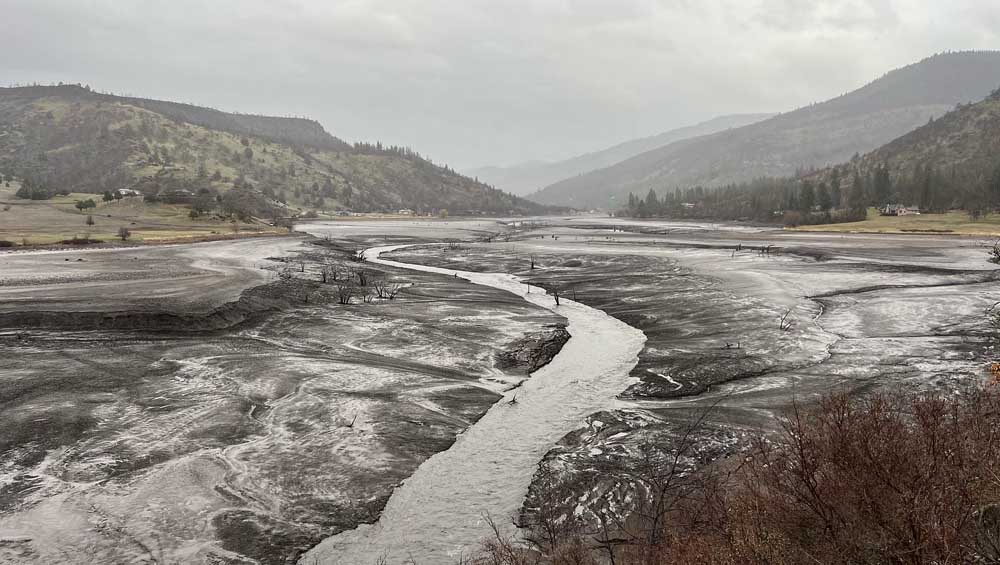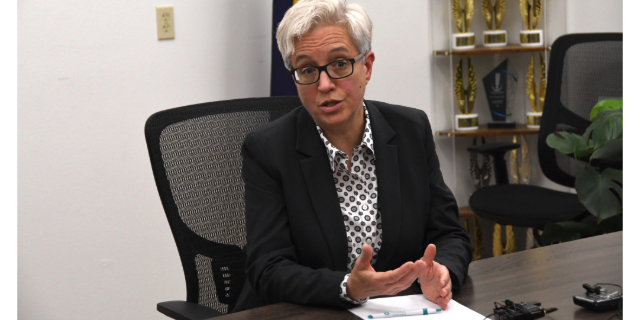Klamath River water quality shows improvement after recent testing
Published 10:00 am Saturday, June 15, 2024

- The Klamath River flows through sediment collected at the bottom of Copco Reservoir in January, after the lake was drained to prepare for the removal of Copco 1 dam and two other dams later this year. The drawdown of the lake, along with the concurrent drawdown of reservoirs behind the Iron Gate and JC Boyle dams, sent heavy volumes of sediment downriver.
Water tests in the Klamath River’s main stem indicate that spikes in heavy metals that accumulated behind three hydroelectric dams slated for removal “have now been resolved” and that the water is safe for recreation, agriculture and some drinking.
The drawdown of the three dams — Iron Gate, Copco 1 and JC Boyle — in preparation for their removal later this year involved their breaching in January and February. With the sudden release of sediment-laden water into the Klamath, turbidity levels rose, and water samples that Siskiyou County collected Jan. 31 showed elevated levels of aluminum, arsenic, iron and lead that exceeded thresholds for treated human drinking water.
Mark Bransom, CEO of the Klamath River Renewal Corporation, said in a news release that KRRC commissioned Camas Environmental Professionals, a consulting firm, to test the water quality in early May. The results came back May 29.
Metals in the river water do not pose any risk to human health or to wildlife,” Bransom said in the release.
The recent analysis of water samples noted that “total metal concentrations declined sharply from the Siskiyou County (Jan. 31) sampling date … with cadmium, chromium-VI, lead, mercury, nickel, silver and zinc not detected or below laboratory reporting limits during the May 1-2 sampling. For aluminum, iron and arsenic, total concentrations also declined substantially from late January to early May.”
In his release, Bransom said Camas collected water samples from 10 locations along the Klamath from just upstream of the former John C. Boyle Reservoir footprint in Oregon to Happy Camp, California, from eight locations in California and, the following day, from two locations in Oregon.
According to the release, “the ice-chilled samples were delivered to the Neilson Research Corporation laboratory in Medford on the days they were collected. The laboratory reports provided by Neilson were then evaluated by an independent water quality analyst, Dr. Jacob Kann of Aquatic Ecosystem Sciences LLC. Dr. Kann has extensive Klamath River water quality experience.
“Both experts from Camas and Dr. Kann concluded that the river remains safe for recreation and agricultural uses and can be safely used as a raw water source for public drinking water systems that include filtration and treatment.
“Currently no public drinking water systems pull directly from the Klamath River, but the Caltrans Collier Rest Area on Interstate 5 will resume using Klamath River water as a drinking water source in mid-June. The rest area has a robust system for water filtration and treatment and will test the filtered/treated water prior to resuming distribution to restrooms and drinking fountains at the rest area.
“We were very pleased to see that water quality is steadily improving and any short-term concentrations of heavy metals that had accumulated in the reservoir sediment have now dissipated,” Bransom said. “The Renewal Corporation understands the community’s concerns about water quality, and our hope is that this recent round of testing will put any remaining concerns to rest.”






